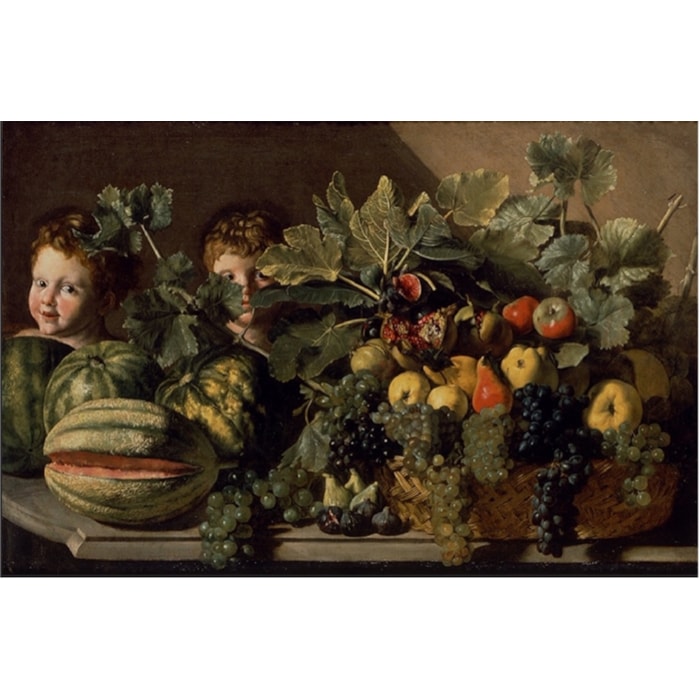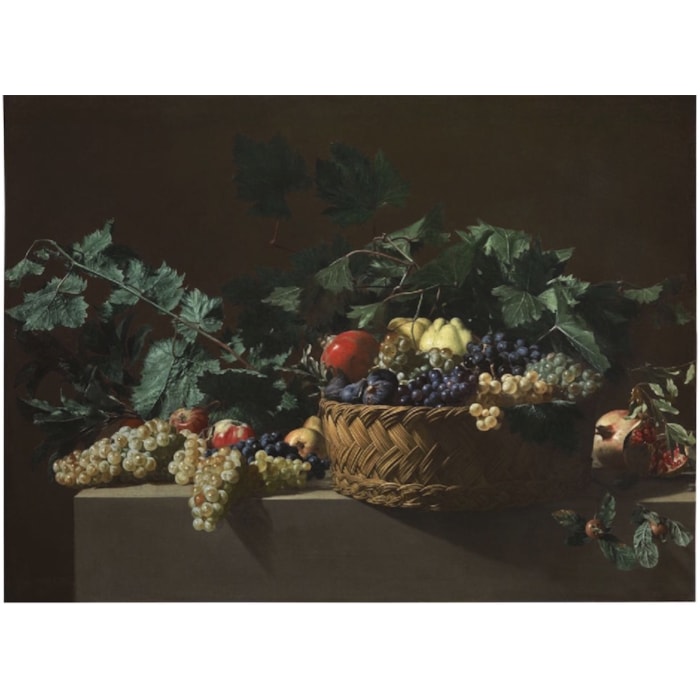Bartolomeo Cavarozzi (Viterbo 1587 - Roma 1625)
(Viterbo, 1587 – Roma, 1625)
Natura morta con cesta di frutta con uve, melone, melograno e meleOlio su tela, 51 x 67 cm
- PROVENIENZA
- BIBLIOGRAFIA
- MOSTRE
- DESCRIZIONE
PROVENIENZA
Collezione privata
BIBLIOGRAFIA
-Véronique Damian, in Sweerts, Tanzio, Magnasco et autres protagonistes du Seicento italien, Paris, Galerie Canesso, 2009, pp.18-21;
-Franco Paliaga, in L’origine della Natura Morta in Italia. Caravaggio e il Maestro di Hartford, Anna Coliva – Davide Dotti (a cura di), cat. della mostra, Roma, Galleria Borghese, 16 novembre 2016 – 19 febbraio 2017, p. 201 fig. 32; pp. 246-247, n. 32.
MOSTRE
- L’origine della Natura Morta in Italia. Caravaggio e il Maestro di Hartford, Anna Coliva – Davide Dotti (a cura di), Roma, Galleria Borghese, 16 novembre 2016 - 12 marzo 2017, n. 32.
DESCRIZIONE
Il motivo isolato della Canestra di frutta ci rimanda al celebre prototipo di Caravaggio (1571-1610), oggi conservato alla Pinacoteca Ambrosiana di Milano, che fu tuttavia concepito con uno spirito completamente diverso. Nel nostro dipinto, al contrario della Canestra di Caravaggio, i pieni sono molto più importanti dei vuoti e i frutti sono osservati da un punto di vista ravvicinato, in primo piano. Ciò è ancora più evidente negli insetti, che paiono descritti come se fossero stati osservati attraverso una lente d’ingrandimento.
Le differenze però non si limitano alla concezione d’insieme: anche i dettagli assumono significati opposti. Laddove Caravaggio si prodiga nella resa dello stato di decomposizione dei frutti e delle foglie accartocciate su se stesse per la mancanza d’acqua, il nostro artista, al contrario, esalta i suoi frutti, presentandoceli aperti, spaccati per l’eccessiva esposizione al sole, che esibiscono la propria polpa invitante e le bucce rosse e gialle da frutti maturi.
Lo spazio del dipinto è interamente occupato dal soggetto: il cesto poggia sul bordo di un semplice ripiano di legno e sembra quasi affiorare dalla superficie della tela. Abbiamo voglia di tendere la mano per cogliere gli invitanti grappoli d’uva, di diverse varietà, che debordano all’esterno del cesto. L’artista non cattura l’oggetto in posa, come in un ritratto, bensì un’immagine di vita e di piacere che parla ai sensi. I frutti in piena luce appaiono cesellati contro lo sfondo bruno caldo e a volte un sottile tratto nero delinea i bordi, come nel caso del melograno posto in equilibrio sull’apice della esuberante costruzione piramidale. Siamo quasi stupiti, davanti a tanta prodigalità, nel notare la presenza di qualche mosca che era sfuggita a un primo sguardo, di una libellula e due farfalle che improvvisano un grazioso balletto aereo intorno alle foglie e di constatare l’equilibrio precario, quasi improbabile, dei frutti. Si tratta di una composizione costruita ad arte, più che di un’osservazione dal vero.
Questo dipinto parla di esuberanza, non di austerità. Esuberanza prima di tutto del colore, con un chiaro compiacimento nel crearlo puro e audace; esuberanza nella scelta dei motivi, moltiplicati in tutte le possibili combinazioni, come nel caso dell’uva e delle mele, che variano nella forma e nel colore. Senza dubbio il dipinto aveva la funzione di sovrapporta perché la fisicità e l’impatto visivo di questo cesto di frutta sono potenti. Le foglie, dall’effetto marmorizzato, sembrano ricavate da un materiale minerale, tanto appaiono solide nello spazio.
Il dipinto è stato esposto nel 2017 come “Pittore caravaggesco” alla mostra L’origine della Natura Morta in Italia. Caravaggio e il Maestro di Hartford della Galleria Borghese. Franco Paliaga, nella scheda del catalogo, avvicina la nostra opera al corpus del misterioso Maestro della natura Morta Aquavella e termina la scheda scrivendo “in virtù dell’altissima qualità pittorica, (quest’opera) si qualifica come una delle prove più alte della natura morta post-caravaggesca”.
Gianni Papi, seguito da Mina Gregori, Daniele Sanguinetti e Marco Pupillo, danno una parte delle opere del Maestro dell’Acquavella a Bartolomeo Cavarozzi.
Anche se non tutta la critica concorda con questa proposta, l’attribuzione a Cavarozzi di una serie di Nature morte autonome – come ad esempio la tela presentata a TEFAF nel 2017 ed oggi in collezione privata – risulta ormai assodata.
Gianni Papi ha studiato il nostro dipinto nel 2018 iscrivendolo al corpus delle nature morte del pittore viterbese (Exp. Gianni Papi, 24 gennaio 2018).
Note:
1 - G. Papi, Riflessioni sul percorso caravaggesco di Bartolomeo Cavarozzi, in «Paragone», 47, s. 3, 5-7, 1996 (1997), pp. 85-96.
2 - M. Gregori, Natura morta italiana 2002, pp. 33-34.
3 - D. Sanguinetti, Bartolomeo Cavarozzi 2005, pp. 18-19.
4 - M. Pupillo, Bartolomeo Cavarozzi in I Caravaggeschi. Percorsi e protagonisti, a cura di A. Zuccari, II, 2010, p. 355.
5 - A. Cottino, La natura morta 1995, p. 62, pp. 148-153.
6 - P. Curie, in Caravage à Rome. Amis et ennenis, cat. mostra Parigi, musée Jacquemart-André, 21 settembre 2018 – 28 gennaio 2019, pp. 106-107, n. 8.












